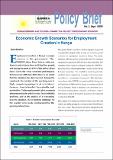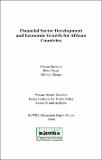| dc.date.accessioned | 2023-02-22T08:47:24Z | |
| dc.date.available | 2023-02-22T08:47:24Z | |
| dc.date.issued | 2007 | |
| dc.identifier.uri | https://repository.kippra.or.ke/handle/123456789/4073 | |
| dc.description.abstract | Achieving sustainable economic growth in Kenya has continued to be elusive. Economic growth has
been characterized by episodes of both high growth rates (1960s, 1970s and after 2003 to present)
and recession (around 2000 with a negative growth rate). Also, the dual nature of the economy has
become more pronounced, with the informal sector growing faster than the formal sector. Looking at sectoral
performance, the share of agriculture and manufacturing in value added has declined over time, while private
services have gained prominence. A review of the economic policy priorities for achieving economic growth
reveals that there has not been a significant shift in sectoral priorities over time. As the economy continues on its
recovery path from the recession experienced in 2000, it is important to establish what could have gone wrong
with Kenya's past growth efforts, and also determine which sectors have the capacity to contribute significantly
to economic growth. | en |
| dc.language.iso | en | en |
| dc.publisher | The Kenya Institute for Public Policy Research and Analysis (KIPPRA) | en |
| dc.relation.ispartofseries | Policy Brief;No. 01 of 2007 | |
| dc.subject | Economic Growth Pattern | en |
| dc.subject | Economic Growth Outcomes | en |
| dc.subject | Sectoral Linkages | en |
| dc.subject | Resource Allocation | en |
| dc.subject | Sustainability | en |
| dc.title | Policy Brief No. 01 of 2007 on Options for Sustaining Kenya’s Economic Growth Pattern | en |
| dc.type | Other | en |
| ppr.contributor.author | The Kenya Institute for Public Policy Research and Analysis (KIPPRA) | en |




